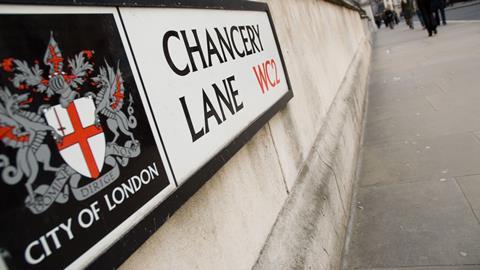The most impressive sign of legal continuity in London's Chancery Lane is not the neoclassical frontage of the Law Society's Hall or the 17th-century brickwork of Lincoln's Inn. It is the line of the street itself: the gentle S-shape it wends northward from Carey Street to Holborn. When the Knights Templar carved out their 'new lane' to reach newly acquired property to the south of Fleet Street they respected boundaries established in Saxon times, and quite possibly previously.
Those boundaries are still there, nowadays marking the western edge of the City of London. Chancery Lane's curves and continuity of title survived the Great Fire of London - which was contained just to the east, at Fetter Lane - and the Blitz. They even survived the petrol-head developers of the 1960s, with their mad visions of urban motorways.
And, while optimism may be premature, Chancery Lane's unique character seems to have survived the Covid pandemic. Legal practices are returning to the street and its surrounding areas, and so are the businesses that serve them.
Chancery Lane is a perfect example of what London's biographer Peter Ackroyd calls 'the city's topographical imperative, whereby the same activity takes place over hundreds of years in the same small area'. No one decreed that this quarter should become legal London, unless you count the decision to site the Office of the Six Clerks on the lane (where the Law Society's Hall stands now). Until the Victorian age, areas just outside the City walls - 'beyond the bars' - were largely left to develop their individual characters. Some attracted bear pits and knocking shops. Chancery Lane attracted lawyers.
The Royal Courts of Justice, when it opened in 1882, merely acknowledged the district's existing character, as did the other legal institutions dotted around in an ecosystem evocatively portrayed in Dickens' Bleak House.
In the last quarter of the twentieth century, that ecosystem seemed to be breaking up. The Public Record Office moved from Chancery Lane to Kew, the Patent Office from Southampton Buildings of Furnival Street to southeast Wales. Meanwhile, new giant merged legal practices, like the banks and newspapers before them, eschewed Dickensian terraces for glass towers in Docklands.
Walking the shuttered and almost deserted lane during that bleak winter of 2020-21, it was easy to believe the decline might be terminal.
But Chancery Lane's topographical imperative is stronger than that. A rump of legal activity kept going even in the worst months and now the offices are reopening. An early vote of confidence was national firm Slater and Gordon's return to the lane - albeit in a slimmed down shared workspace. Other firms reconsidering their office footprint are likely to follow. Meanwhile it is significant that US firm Armstrong Teasdale has chosen the area (well, Lincoln's Inn fields) rather than the City or Docklands for its first London office.
And now, just around the corner in Fleet Street, the government - well, the City of London - is for the first time deliberately creating a planned 'Legal Quarter'. This will be centred an 18-room courthouse, a new HQ for the City of London Police and an unspecified commercial development. Predictably, the plan prompted outrage from Fleet Street veterans. I didn't agree with them. Sure, it was sad to lose the frontage of Chronicle House and perhaps the Hack and Hop pub, but a courtroom and copshop create a lot more vibrancy than a high-rise desert of management consultants. We shall see if the City is bold enough to encourage a mixed use of the development's planned open space to create the comfortable chaos which enlightened planners like Canada's Charles Montgomery recognise as vital to the 'happy city'.
A more immediate test will be the success of the redeveloped Chancery House, the four-story slab above the London Silver Vaults at the top of Chancery Lane. It is re-opening in the spring as a prestige serviced office, with a gym, yoga studio and infra-red saunas. Of more use to the neighbourhood, the adjacent parking lot is to become publicly accessible green space.
Of course office space alone cannot create a living city. Legal London is lucky with its pubs (perhaps not by coincidence) but its retailers and restaurants were walloped by the pandemic and some will never return. And part of the mix must be affordable housing - a problem that requires more imaginative solutions than any currently on the agenda.
Pioneering Danish architect Jan Gehl once said: 'A good city is like a good party: people stay longer than really necessary because they are enjoying themselves.' Not many Chancery Lane lawyers see their working lives as a party, but with a little enlightened nudging we can preserve and build on a rich topographical imperative. So long as we never let anyone iron out those prehistoric wiggles in the lane.
Further reading
- London: The biograpy, Peter Ackroyd
- Happy City: Transforming our lives through Urban Design, Charles Montgomery
- Cities for People, Jan Gehl



































No comments yet